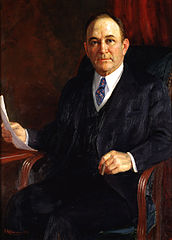Joseph Taylor Robinson
 | |
| Data i miejsce urodzenia | 26 sierpnia 1872 |
|---|---|
| Data śmierci | |
| 3. lider większości Senatu Stanów Zjednoczonych | |
| Okres | od 4 marca 1933 |
| Przynależność polityczna | |
| Poprzednik | James Eli Watson |
| Następca | |
| Senator Stanów Zjednoczonych z Arkansas (Klasa 2) | |
| Okres | |
| Poprzednik | William M. Kavanaugh |
| Następca | John E. Miller |
| 29. gubernator stanu Arkansas | |
| Okres | od 16 stycznia 1913 |
| Poprzednik | George Washington Donaghey |
| Następca | William Kavanaugh Oldham |
Joseph Taylor Robinson (ur. 26 sierpnia 1872, zm. 14 lipca 1937) – amerykański polityk, prominentny działacz Partii Demokratycznej.
Urodził się w Lonoke w stanie Arkansas. Uczęszczał na uniwersytet stanowy, po czym dalej studiował prawo na prestiżowym uniwersytecie Wirginia, założonym przez samego Thomasa Jeffersona.
Jego kariera polityczna rozpoczęła się od wybrania go w roku 1894 członkiem stanowej legislatury, gdzie urzędował jedną kadencję. W roku 1802 wygrał mandat kongresmena, który piastował do roku 1913.
Wtedy to został wybrany gubernatorem Arkansas, skutkiem czego zrezygnować musiał z mandatu reprezentanta, lecz po zaledwie kilkunastu dniach urzędowania zrezygnował, aby ponownie zasiąść w ławach kongresowych. Tym razem jednak jako senator, mianowany po nagłej śmierci swego poprzednika na tym urzędzie Jeffersona Davisa. Robinson był ostatnim senatorem wybranym przez legislaturę stanową.
Mimo tak krótkiej kadencji gubernatorskiej w tym czasie kazał wybudować nowy kapitol stanowy, zaaprobował nową flagę i zajął się reformą systemu pracy.
Odnowił swój mandat senatora w wyborach powszechnych. Od roku 1922 był liderem demokratów w wyższej izbie kongresu (byli wtedy w mniejszości wobec republikanów).
Prezydencki kandydat demokratów w wyborach roku 1928 Al Smith mianował swoim wiceprezydenckim kandydatem senatora Robinsona, ale przegrali wówczas z republikanami Herbertem Hooverem i Charlesem Curtisem.
W roku 1933, po zwycięstwie demokratów w wyborach kongresowych i prezydenckich (prezydentem został wtedy Franklin Delano Roosevelt) Robinson został liderem większości (pierwszym demokratą na tym stanowisku). Popierał aktywnie reformy Nowego Ładu. Funkcję lidera większości zajmował do roku 1937, kiedy zmarł.
Linki zewnętrzne
- Biografia w Biographical Directory of the United States Congress (ang.)
Media użyte na tej stronie
Logo of the Democratic Party of the United States. Dark blue D inside a dark blue circle.
Unofficial, alternate version of the seal of the United States Senate. The official seal has significant restrictions on its use, and this is often used in its place. This version is just the Great Seal of the United States with a Senate inscription.
Seal of the Vice President of the United States. The blazon is defined in Executive Order 11884 as:
The design is the same as the Seal of the President of the United States, except that there is no ring of stars, the clouds are gray (instead of proper), the stars are gray (instead of argent), the scroll is gray (instead of white), the arrows are gray (instead of proper), and the background colors and inscription (obviously) differ.The Coat of Arms of the Vice President of the United States shall be of the following design:
SHIELD: Paleways of thirteen pieces argent and gules, a chief azure; upon the breast of an American eagle displayed holding in his dexter talon an olive branch proper and in his sinister a bundle of thirteen arrows gray, and in his beak a gray scroll inscribed "E PLURIBUS UNUM" sable.
CREST: Behind and above the eagle a radiating glory or, on which appears an arc of thirteen cloud puffs gray, and a constellation of thirteen mullets gray.
The Seal of the Vice President of the United States shall consist of the Coat of Arms encircled by the words "Vice President of the United States."







